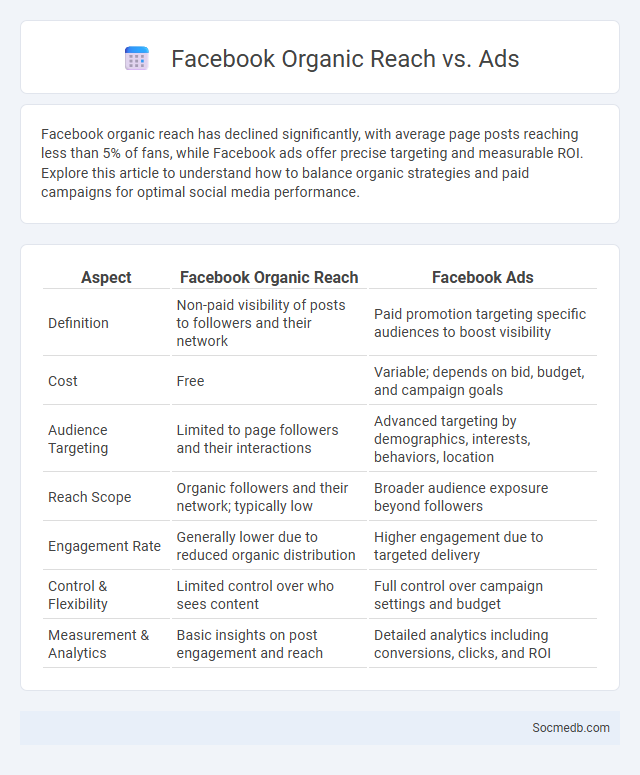
Photo illustration: Facebook Organic Reach vs Ads
Facebook organic reach has declined significantly, with average page posts reaching less than 5% of fans, while Facebook ads offer precise targeting and measurable ROI. Explore this article to understand how to balance organic strategies and paid campaigns for optimal social media performance.
Table of Comparison
| Aspect | Facebook Organic Reach | Facebook Ads |
|---|---|---|
| Definition | Non-paid visibility of posts to followers and their network | Paid promotion targeting specific audiences to boost visibility |
| Cost | Free | Variable; depends on bid, budget, and campaign goals |
| Audience Targeting | Limited to page followers and their interactions | Advanced targeting by demographics, interests, behaviors, location |
| Reach Scope | Organic followers and their network; typically low | Broader audience exposure beyond followers |
| Engagement Rate | Generally lower due to reduced organic distribution | Higher engagement due to targeted delivery |
| Control & Flexibility | Limited control over who sees content | Full control over campaign settings and budget |
| Measurement & Analytics | Basic insights on post engagement and reach | Detailed analytics including conversions, clicks, and ROI |
Understanding Facebook Organic Reach
Facebook organic reach refers to the number of unique users who see your content without paid promotion, influenced by factors like post engagement, content type, and timing. Algorithms prioritize content that fosters meaningful interactions, such as comments and shares, over passive views, reducing visibility for pages relying solely on organic reach. Businesses must create high-quality, relevant posts tailored to their target audience and encourage interaction to maximize organic reach and improve overall Facebook engagement.
The Mechanics of Facebook Paid Ads
Facebook paid ads operate through a bidding system where advertisers compete to display their content to specific target audiences based on demographics, interests, and behaviors. You can set budgets, choose ad placements across Facebook's network, and optimize campaigns using detailed analytics and performance metrics. Effective Facebook ads leverage precise targeting, compelling visuals, and clear calls-to-action to maximize engagement and return on investment.
Organic Reach vs Paid Reach: Key Differences
Organic reach on social media refers to the number of users who see content without paid promotion, driven primarily by algorithms favoring relevance and user engagement. Paid reach involves targeting specific audiences through paid advertisements, ensuring broader visibility and precise demographic targeting beyond the limitations of organic growth. Understanding these differences helps marketers allocate budget efficiently to maximize brand awareness and user interaction.
Factors Influencing Organic Reach on Facebook
Facebook's organic reach is heavily influenced by factors such as content relevance, user engagement, and posting frequency. Algorithms prioritize posts that generate meaningful interactions including comments, shares, and reactions, making quality content essential for visibility. You can improve your organic reach by tailoring posts to your audience's interests and encouraging active participation.
Cost-Benefit Analysis: Organic vs Ads
Analyzing the cost-benefit of social media reveals that organic content leverages authentic engagement without direct expenses, fostering long-term audience trust while requiring consistent effort and creativity. Paid ads demand financial investment but deliver precise targeting, quicker reach, and measurable ROI, ideal for campaigns needing immediate impact or specific conversions. Your strategic choice depends on balancing budget constraints against desired speed, reach, and engagement quality to maximize social media effectiveness.
Content Strategies for Maximizing Organic Reach
Creating engaging, shareable content tailored to the target audience drives organic reach on social media platforms. Leveraging trending topics, optimizing post timing based on audience activity, and incorporating relevant hashtags enhance visibility and interaction. Consistent posting schedules combined with authentic storytelling foster community growth and elevate brand authority without paid promotion.
Targeting and Personalization with Facebook Ads
Facebook Ads leverage advanced targeting options such as custom audiences, lookalike audiences, and detailed demographic filters to deliver highly personalized content tailored to user interests, behaviors, and location. By utilizing Facebook's machine learning algorithms, advertisers can optimize ad placement and content in real time, improving engagement rates and conversion efficiency. Precise targeting combined with dynamic personalization increases ROI by ensuring ads are shown to the most relevant users, reducing ad spend waste.
Measuring ROI: Organic Efforts vs Paid Campaigns
Measuring ROI on social media requires analyzing key metrics such as engagement rates, conversion rates, and cost-per-acquisition for both organic efforts and paid campaigns. Your brand's organic reach can build long-term loyalty and credibility, but paid campaigns often deliver faster, trackable results with customizable targeting options. Comparing these data points helps optimize budget allocation and maximize overall marketing effectiveness on platforms like Facebook, Instagram, and LinkedIn.
Best Practices for Combining Organic and Paid Reach
Maximizing social media impact requires integrating organic content with paid advertising to enhance audience engagement and brand visibility. Leveraging data analytics helps identify high-performing organic posts to boost with targeted ads, increasing ROI and reach efficiency. Consistent messaging and tailored content strategies across both channels ensure cohesive brand storytelling and optimized user interaction.
Future Trends: The Evolving Landscape of Facebook Reach
Facebook reach is increasingly driven by personalized content algorithms and augmented reality features, reshaping user engagement patterns. Brands leveraging AI-powered analytics can predict trends and optimize posts for maximum visibility in evolving user feeds. Your social media strategy must adapt to these future trends to maintain and grow audience connection effectively.
 socmedb.com
socmedb.com